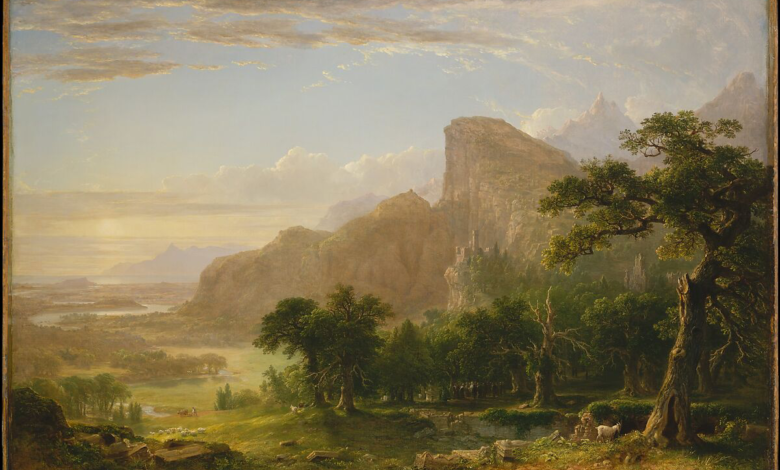Asher Brown Durand: Master of American Landscape Painting

Asher Brown Durand, born on August 21, 1796, in Jefferson Village (now Maplewood), New Jersey, stands as a pivotal figure in American art, particularly known for his contributions to the Hudson River School. Durand’s journey from a skilled engraver to a celebrated landscape painter reflects his deep appreciation for nature and his dedication to capturing its serene beauty on canvas. His works are not merely artistic expressions but are also imbued with philosophical reflections on nature and human existence.
Early Life and Career
Durand’s artistic inclinations were evident from a young age. Initially trained as an engraver, he apprenticed with Peter Maverick in Newark, New Jersey. Durand’s engraving skills were highly regarded, leading him to establish his own engraving business in New York City. His meticulous attention to detail and mastery of technique were evident in his engraving of John Trumbull’s painting “The Declaration of Independence,” which brought him significant acclaim.
Despite his success in engraving, Durand’s true passion lay in painting. Inspired by the burgeoning interest in landscape art and influenced by the works of Thomas Cole, the founder of the Hudson River School, Durand transitioned to painting in the 1830s. This shift marked the beginning of his most celebrated phase, during which he produced some of the most iconic landscape paintings in American art history.
The Hudson River School and Artistic Philosophy
The Hudson River School, a mid-19th century American art movement, was characterized by its romantic portrayal of the American wilderness. Durand, along with his contemporaries, sought to depict the natural beauty of the American landscape, emphasizing its sublime and tranquil qualities. The movement was not just about aesthetics; it was also deeply rooted in transcendentalist philosophy, which viewed nature as a manifestation of the divine.
Durand’s paintings are a testament to his belief in the spiritual and moral benefits of nature. His works often depict untouched landscapes, with an emphasis on light, texture, and atmosphere. He believed that through careful observation and faithful representation of nature, artists could inspire a sense of reverence and contemplation in viewers.
Notable Works and Techniques
Durand’s oeuvre includes a vast array of landscapes, each meticulously crafted to capture the essence of the scene. One of his most famous works, “Kindred Spirits” (1849), depicts the poet William Cullen Bryant and Thomas Cole standing on a rocky ledge in the Catskill Mountains, overlooking a pristine landscape. This painting is not only a tribute to his friend Cole but also a celebration of the bond between art and nature.
Another significant work, “The First Harvest in the Wilderness” (1855), portrays a serene scene of settlers harvesting in a clearing, with the wilderness looming around them. This painting reflects Durand’s fascination with the interaction between humans and nature, highlighting both the beauty and the challenges of pioneering life.
Durand’s technique involved detailed preparatory sketches and studies from nature, which he would then refine in his studio. His use of light and shadow, along with a keen attention to detail, created a sense of depth and realism in his landscapes. He often employed a soft, diffused light to enhance the tranquil and ethereal quality of his scenes.
Legacy and Influence
Durand’s impact on American art extends beyond his paintings. As a mentor and advocate for young artists, he played a crucial role in shaping the next generation of landscape painters. His writings, particularly the influential “Letters on Landscape Painting” (1855), provided practical advice and philosophical insights, encouraging artists to study nature directly and to remain faithful to their own observations.
Durand’s dedication to the principles of the Hudson River School and his contributions to American landscape painting earned him a lasting legacy. His works are housed in major museums and collections, including the Metropolitan Museum of Art, the National Gallery of Art, and the Smithsonian American Art Museum. These institutions continue to celebrate Durand’s artistry and his role in defining a distinctly American artistic identity.
Durand’s Relevance Today
In contemporary times, Asher Brown Durand’s paintings resonate with audiences for their timeless beauty and ecological sensitivity. As society grapples with environmental issues, Durand’s reverence for nature and his meticulous depictions of pristine landscapes serve as a poignant reminder of the need to preserve and cherish our natural world.
Moreover, Durand’s emphasis on observation and authenticity in art remains relevant for modern artists. His belief that true artistry comes from a deep engagement with nature and a commitment to personal vision continues to inspire and instruct.
Conclusion
Asher Brown Durand’s contributions to American art are profound and enduring. His landscapes, imbued with a sense of tranquility and reverence for nature, reflect the ideals of the Hudson River School and the transcendentalist movement. Through his meticulous technique and philosophical approach, Durand captured the sublime beauty of the American wilderness, leaving a legacy that continues to inspire appreciation for both art and nature.
In exploring Durand’s paintings, we are reminded of the powerful connection between humanity and the natural world, a connection that Durand so eloquently portrayed on canvas. His works invite us to pause, reflect, and find solace in the serene beauty of the landscapes he so masterfully rendered.



